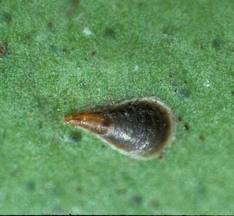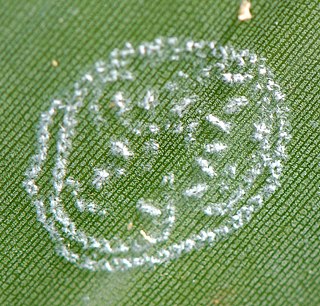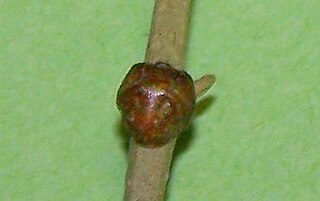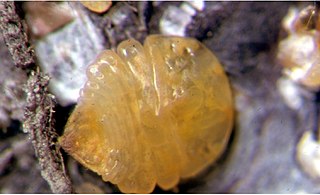
Scale insects are small insects of the order Hemiptera, suborder Sternorrhyncha. Of dramatically variable appearance and extreme sexual dimorphism, they comprise the infraorder Coccomorpha which is considered a more convenient grouping than the superfamily Coccoidea due to taxonomic uncertainties. Adult females typically have soft bodies and no limbs, and are concealed underneath domed scales, extruding quantities of wax for protection. Some species are hermaphroditic, with a combined ovotestis instead of separate ovaries and testes. Males, in the species where they occur, have legs and sometimes wings, and resemble small flies. Scale insects are herbivores, piercing plant tissues with their mouthparts and remaining in one place, feeding on sap. The excess fluid they imbibe is secreted as honeydew on which sooty mold tends to grow. The insects often have a mutualistic relationship with ants, which feed on the honeydew and protect them from predators. There are about 8,000 described species.

The San Jose scale is a hemipterous insect in the family Diaspididae. It is an agricultural pest as it causes damage and crop losses to many fruit crops. In 1914, Q. perniciosus became the first documented case of insecticide resistance.

Diaspididae is the largest family of scale insects with over 2650 described species in around 400 genera. As with all scale insects, the female produces a waxy protective scale beneath which it feeds on its host plant. Diaspidid scales are far more substantial than those of most other families, incorporating the exuviae from the first two nymphal instars and sometimes faecal matter and fragments of the host plant. These can be complex and extremely waterproof structures rather resembling a suit of armor. For this reason these insects are commonly referred to as armored scale insects. As it is so robust and firmly attached to the host plant, the scale often persists long after the insect has died.

Halimococcidae is a family of scale insects in the order Hemiptera. Members of the family are commonly known as pupillarial palm scales or halimococcids. Most species are found on the leaves of palm trees where they suck sap, but some species occur on Pandanus. The family was named by Brown and McKenzie in 1962 and includes five known genera and twenty one species.

Lepidosaphes beckii also known as purple scale, mussel scale, citrus mussel scale, orange scale, comma scale and mussel purple scale is a scale insect that is a pest of Citrus trees. The small insects attach themselves to leaves, fruits and small branches and cause injury by sucking the tree's sap.

Aulacaspis yasumatsui, or cycad aulacaspis scale (CAS), is a scale insect species in the genus Aulacaspis that feeds on cycad species such as Cycas revoluta or Dioon purpusii. Other common names include the cycad scale, the sago palm scale, and the Asian cycad scale. This is a serious pest of cycads which can kill its host plant.

Pinnaspis, first described by Theodore Dru Alison Cockerell in 1892, is a genus of scale insects belonging to the family Diaspididae, or armored scale insects. There are currently 42 species within the genus Pinnaspis.

Aleurodicus dispersus, the spiralling whitefly, is a species of small, white sap-sucking insect, a true bug in the order Hemiptera. It originated in Central America and the Caribbean region and has spread to many of the world's tropical and subtropical regions, where it has become a major pest of agricultural crops.

Coccus hesperidum is a soft scale insect in the family Coccidae with a wide host range. It is commonly known as brown soft scale. It has a cosmopolitan distribution and feeds on many different host plants. It is an agricultural pest, particularly of citrus and commercial greenhouse crops.

Aonidiella orientalis is a species of insect in the family Diaspididae, the armored scale insects. It is known commonly as the Oriental yellow scale. It is an agricultural pest on a wide variety of crop plants.
Aonidiella citrina or yellow scale is an armored scale insect from the family Diaspididae. It feeds by sucking sap from plants in a number of plant families, but is mostly known for being a pest of citrus.
Aonidomytilus crookiae is a species of scale insect in the family Diaspididae which are often referred to as "armored scale insects." It is commonly known as "St. John's Wort Scale." Originally named Nelaspis crookiae by Gordon Floyd Ferris in 1954, the taxon was moved to the genus Aonidomytilus in 1984 as the result of a 1979 taxonomic revision of the genus. Aonidomytilus multiglandulatus is a junior synonym.

Pseudaulacaspis pentagona, the white peach scale or mulberry scale, is a species of armoured scale insect in the family Diaspididae. This scale infests over 100 different genera of plants including many fruit trees and ornamentals.
Hemiberlesia lataniae, the latania or palm scale, is a species of armored scale insect in the family Diaspididae. It was first described by the French entomologist Victor Antoine Signoret in 1869 using Latania lontaroides, a species of palm tree endemic to Réunion as its host; since then, it has been found on avocado trees growing in South Africa, Australia, Israel, the United States, and on a range of other plants in many parts of the world.

Aspidiotus destructor, the coconut scale, is a species of armoured scale insect in the family Diaspididae, found in many tropical and subtropical parts of the world. It is a serious pest of coconut and banana, and attacks a range of other fruiting trees and ornamental plants.

Chilocorus cacti, known generally as the cactus lady beetle or the twice-stabbed cactus lady beetle, is a species of lady beetle in the family Coccinellidae. It is native to the Caribbean region, North America, Central America, and South America. The adults and larvae feed on scale insects and attempts have been made to use it for biological pest control.

Saissetia oleae is a scale insect in the family Coccidae. It is considered one of the three main phytophagous parasites of the olive tree, together with the olive fruit fly and the olive moth. Although it is a common parasite which occurs most often in olive trees, it is a polyphagous species, also attacking citrus trees as well as various ornamental shrubs such as oleanders, pittosporums, sago palm, and euonymus.

Quadraspidiotus juglansregiae, commonly known as the walnut scale, is a species of armoured scale insect in the family Diaspididae. It is native to North America where it feeds on a wide range of ornamental and forest trees and bushes.
Carulaspis minima is an armoured scale insect, in the subtribe Diaspidina of the family Diaspididae, and is commonly known as the minute cypress scale. It was first described in 1869 by the French entomologist Victor Antoine Signoret. It feeds on evergreen conifers in the families Cephalotaxaceae, Cupressaceae and Taxodiaceae.

Ceroplastes ceriferus, the Indian wax scale, is a species of scale insect in the family Coccidae. It is native to southern Asia and has spread to many other parts of the world.















